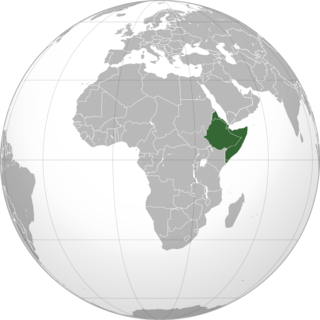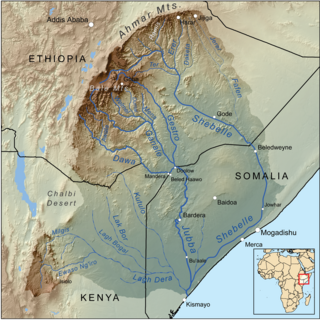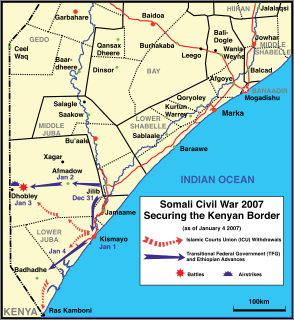
The Horn of Africa is a peninsula in Northeast Africa. It extends hundreds of kilometers into the Arabian Sea and lies along the southern side of the Gulf of Aden. The area is the easternmost projection of the African continent. Referred to in ancient and medieval times as the land of the Barbara and Habesha, the Horn of Africa denotes the region containing the countries of Djibouti, Eritrea, Ethiopia, and Somalia.

The Shebelle River begins in the highlands of Ethiopia, and then flows southeast into Somalia towards Mogadishu. Near Mogadishu, it turns sharply southwest, where it follows the coast. Below Mogadishu, the river becomes seasonal. During most years, the river dries up near the mouth of the Jubba River, while in seasons of heavy rainfall, the river actually reaches the Jubba and thus the Somali Sea.

The Somali Regional State or the Ogaden, is the largest and easternmost of the nine ethnic divisions (kilimo) of Ethiopia. The state borders the Ethiopian states of Afar, the chartered city Dire Dawa, Oromia to the west, as well as Djibouti to the north, Somalia to the north, east, and south, and Kenya to the south-west.

Ogaden is the unofficial name of the Somali Region, the territory comprising the eastern portion of Ethiopia. The inhabitants are predominantly ethnic Somalis.

Greater Somalia comprises the regions in or near the Horn of Africa in which ethnic Somalis live and have historically inhabited. The territory historically encompassed British Somaliland, Italian Somaliland, French Somaliland, the Ogaden in the Ethiopian Empire, and the Northern Frontier District in the Colony and Protectorate of Kenya - at the present day, it encompasses Somalia, eastern Djibouti, the Somali region and Dire Dawa in Ethiopia, and the Lamu, Garissa, Wajir and Mandera Counties in Kenya.

Dire Dawa is one of two chartered cities in Ethiopia. It is divided administratively into two woredas, the city proper and the non-urban woreda of Gurgura.

The Ogaden War was a Somali military offensive between July 1977 and March 1978 over the disputed Ethiopian region of Ogaden, which began with the Somali invasion of Ethiopia. The Soviet Union disapproved of the invasion and ceased its support of Somalia, instead starting to support Ethiopia; the United States, conversely, ceased its support of Ethiopia and started supporting Somalia. Ethiopia was saved from a major defeat and a permanent loss of territory through a massive airlift of military supplies, the arrival of 16,000 Cuban troops, 1,500 Soviet advisors and two brigades from South Yemen, also airlifted to reinforce Harar. The Ethiopians prevailed at Harar, Dire Dawa and Jijiga, and began to push the Somalis systematically out of the Ogaden. By March 1978, the Ethiopians had captured almost all of the Ogaden, prompting the defeated Somalis to give up their claim to the region. A third of the initial Somali National Army invasion force was killed, and half of the Somali Airforce destroyed; the war left Somalia with a disorganized and demoralized army and an angry population. All of these conditions led to a revolt in the army which eventually spiraled into a civil war and Somalia's current situation.

The Ogaden National Liberation Front is a separatist rebel group fighting for the right to self-determination for Somalis in the Somali Region of Ethiopia. The ONLF, established in 1984, demands for the autonomy of this region and has claimed responsibility for several attacks since the beginning of 1994 aimed at Ethiopian forces in the area, which the government considers a region under the new federal system. The area of the Ogaden region stretches at least about 330,000 square kilometres and has over 7 million people, mainly from the Absame Somali tribe. The ONLF claims that Ethiopia is an occupying government, despite the Ogaden being represented in the Ethiopian federal government by groups including the opposition Somali People's Democratic Party (SPDP). The ONLF is composed mainly of members of the Ogaden clan, specifically "the makaahiil tribe of the Ogaden". The armed wing of the ONLF is the Ogaden National Liberation Army (ONLA).

Moyale is a market town on the border of Ethiopia and Kenya, which is split between the two countries: the larger portion is in Ethiopia which is split by the Oromia Region from west and the Somali region from east, and the smaller is in Marsabit County, Kenya.

The Somali Civil War is an ongoing civil war taking place in Somalia. It grew out of resistance to the military junta led by Siad Barre during the 1980s. By 1988–90, the Somali Armed Forces began engaging various armed rebel groups, including the Somali Salvation Democratic Front in the northeast, the Somali National Movement in the northwest, and the United Somali Congress in the south. The clan-based armed opposition groups eventually managed to overthrow the Barre government in 1991.
The Marehan are a Somali clan. They are one of the major Darod sub-clans, forming a part of the Sade confederation of clans. The majority of the Marehan live in the Gedo region (gobolka) in southwestern Somalia, as well as the Galguduud and Mudug regions in central Somalia, the Ogaden region of Ethiopia, and the North Eastern Province of Kenya.

The Somali Civil War was an armed conflict involving largely Ethiopian and Somali Transitional Federal Government (TFG) forces and Somali troops from Puntland versus the Somali Islamist umbrella group, the Islamic Court Union (ICU), and other affiliated militias for control of the country. There is a clear connection between War in Somalia (2009–) and the War of 2006. The war officially began shortly before July 20, 2006 when U.S. backed Ethiopian troops invaded Somalia to prop up the TFG in Baidoa. The TFG in Somalia invited Ethiopians to intervene, which became an "unpopular decision". Subsequently, the leader of the ICU, Sheik Hassan Dahir Aweys, declared "Somalia is in a state of war, and all Somalis should take part in this struggle against Ethiopia". On December 24, Ethiopia stated it would actively combat the ICU.
The Ethiopian–Somali conflict is a territorial and political dispute between the territories of present-day Ethiopia and Somalia. Lasting from the late 1940s, when the Ogaden region was handed over to Ethiopia by the British, into the present day, the tensions culminated in three wars and numerous military clashes alongside the borders. However, because of the Somali Civil War and the lack of a functioning Somali central government since 1991, Ethiopia enjoys the upper hand militarily and economically.
Even before the beginning of the War in Somalia (2006-2009) there were significant assertions and accusations of the use of disinformation and propaganda tactics, classed as forms of information warfare, by various parties to shape the causes and course of the conflict. These include assertions of falsification of the presence or number of forces involved, exaggeration or minimisation of the casualties inflicted or taken, influence or control of media outlets, and other informational means and media to sway popular support and international opinion.

The timeline of events in the War in Somalia during 2007 is set out below.

The Insurgency in Ogaden is an ongoing separatist insurgency, waged by the Ogaden National Liberation Front (ONLF) against the Ethiopian government. The war began in 1994 when the ONLF attempted to recreate the Greater Somalian state by unifying Ethiopia's Somali Region with Somalia.
The 1982 Ethiopian–Somali Border War occurred between June and August 1982 when Ethiopia, sending a 10,000 man invasion force backed by warplanes and armored units, supported by hundreds of SSDF rebels invaded Central Somalia. Siad Barre's regime managed to ultimately repel most of the rebel offensive through declaring a state of emergency in the war zone. The United States government responded by speeding up deliveries of light arms and Pattons already promised. In addition, the initially pledged US$45 million in economic and military aid was increased to US$80 million.

The 2009–present phase of the Somali Civil War is concentrated in southern Somalia. It began in early February 2009 with the conflict between the forces of the Federal Government of Somalia, assisted by African Union peacekeeping troops, and various militant terrorist groups and factions. The violence has displaced thousands of people in the southern part of the country. The conflict has also seen fighting between the Sufi Ahlu Sunna Waljama'a and Al-Shabaab.
Horn Africans in the United States are Americans with ancestry from the Horn of Africa. They include Djiboutian, Eritrean, Ethiopian and Somali individuals.
The following lists events that happened during 2007 in Ethiopia.

















